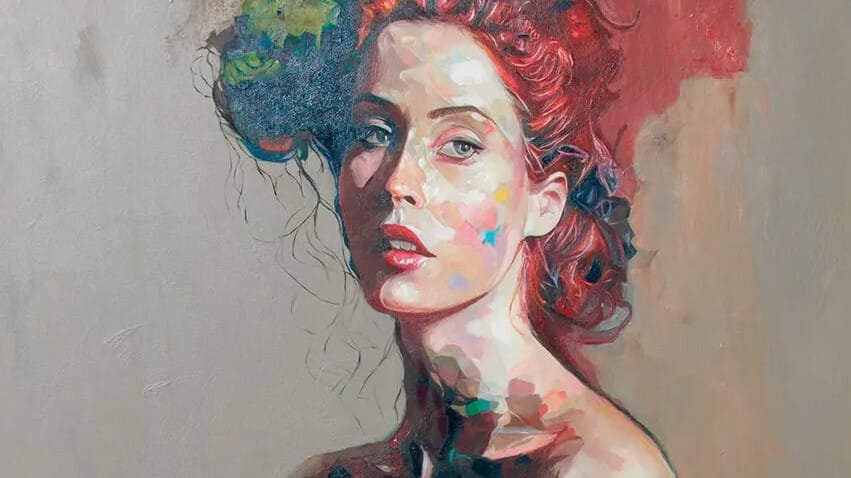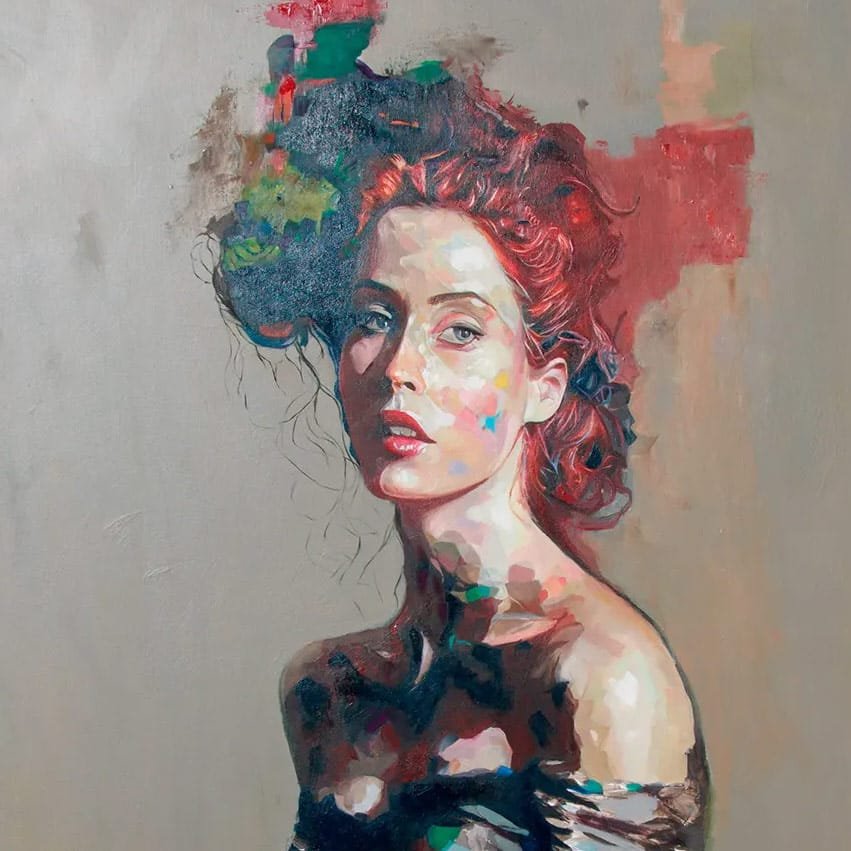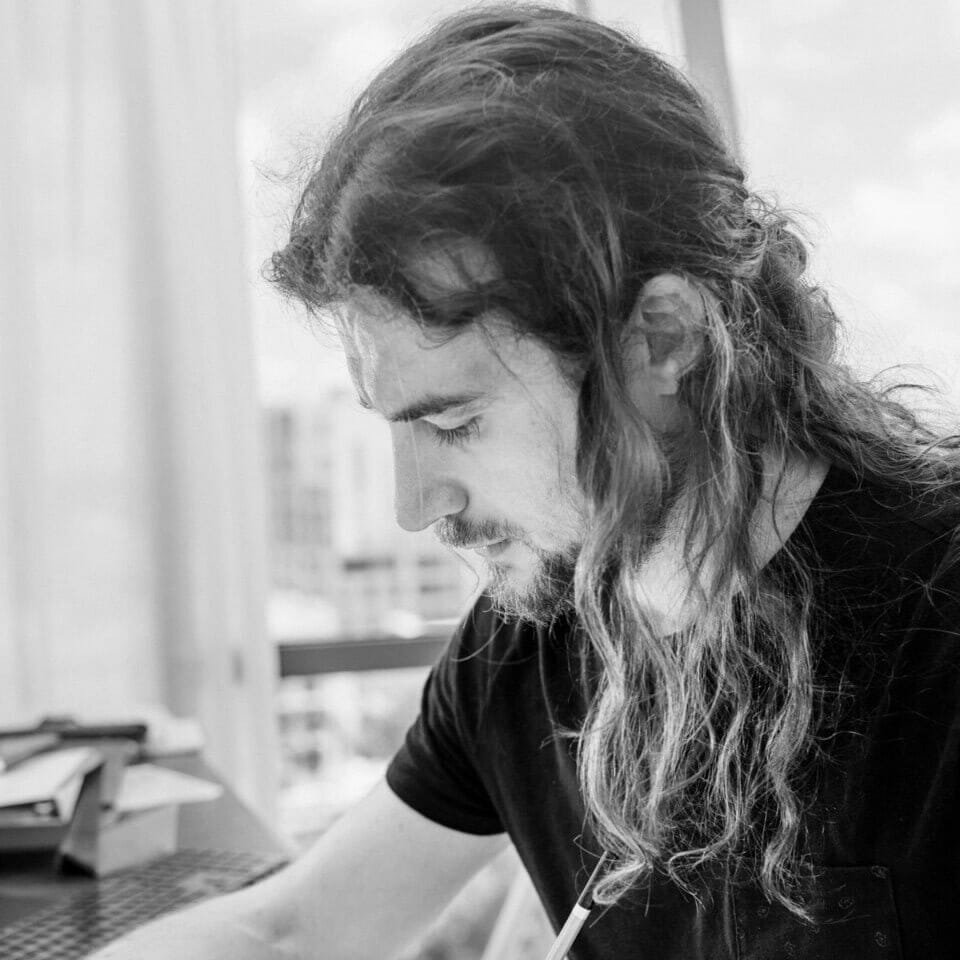Imagine if Leonardo da Vinci’s Mona Lisa had a daughter. This question inspired Alex Righetto’s latest artistic project, “The Daughter of Mona Lisa.”
Merging Past and Present
In creating this painting, Alex Righetto aimed to capture not only the essence of the Italian Renaissance but also to delve into universal themes of beauty and loss. Merging classical and modern elements, his technique unfolds a deeply emotional narrative.
The choice of vibrant and dynamic colors stands in contrast to the original’s serenity, establishing a dialogue between past and present. The painting is not just a tribute to Leonardo but also a contemplation on the cycle of life and the fragility of existence.
A New Perspective on a Classic
Mona Lisa’s Daughter is an oil on canvas much larger than the original, measuring indeed 48 x 60 inches. The multicolored figure of a woman, shown in three-quarter view, stands out against a desolate, neutral background. Rather than employing the sfumato technique, Alex segments the different color areas, which then appear to fragment into primitive spots.
The decomposition of the colors becomes even more evident in the lower part of the painting, where details gradually fade into shades of grey and black.
Without a background or hills to rest one’s gaze upon, everything is summarized by a greenish-brown color that evokes, without directly citing, Leonardo’s work.
The painting is composed of various distinct and connected parts, but also of empty spaces that emphasize an opposition.
The three-quarter position is maintained, although ‘The Daughter’ seems not to be completely seated. Her face radiates vitality and youth, while some minor parts of the body convey decay and death.
A Vision of Contrasts and Complexity
Under the vision of Alex Righetto, the canvas of “The Daughter of Mona Lisa” comes to life as an embodiment of Renaissance grace intertwined with fragments of modernity. The painting displays a woman in an upright posture, her gaze proud and reflective, while the colorful chaos winding through her red hair and along her body suggests a soul dancing between different eras.
Righetto’s art embraces the elusive – the contrast between anatomical precision and abstract brushstrokes creates a dialogue between the human form and bursts of color, reflecting the complexity of human experience. The figure emerges from emptiness, powerful in its presence, almost symbolizing an awakening from time itself.
Artist’s Reflection:
“Many people have become curious about the painting ‘The Mona Lisa’s Daughter.’
This artwork, along with others, was born from the idea of exploring one of the most extraordinary artistic periods of all time, the Renaissance.
One of the most famous paintings in the world is a fruit of that period: Leonardo da Vinci’s Mona Lisa.
During my research on the subject, I was intrigued to discover that Lisa del Giocondo (the subject of the painting) had a stillborn daughter.
I began to explore the idea of depicting the daughter as if she were still alive.
What expression would she have today? The result was a painting that is like a still life, a kind of ‘memento mori’, an emblem of human transience.
A symbol of life and death, represented by an expressive technique that shows extremely lively features of the daughter, like her face, and others where she is clearly a corpse.
A yin and yang, a dichotomy of elements that characterize existence:
light and dark, good and evil, life and death… The painting is not for sale. In fact, I have turned down a considerable offer for it.”
Alex Righetto
A Dialogue of Contrasts
In “The Mona Lisa’s Daughter,” Alex Righetto has woven a visual ode to fragility and eternity, capturing the essence of Yin and Yang, the dichotomy of human experiences through art. Each element of the painting, from the vibrant chromatic tumult atop the woman’s head to the calm areas surrounding her figure, speaks of oppositely but intrinsically linked forces, of life and art intertwined in a dynamic balance.
The figure, captured in a moment of serene reflection, emerges from negative space as a powerful symbol of presence and absence, light and shadow. Righetto’s technique, emphasizing detailed natural lighting, intertwines with form, creating an emotional impact that invites the viewer to intimate reflection, as if before a mirror.
The juxtaposition of youth and maturity, good and evil, is reflected in the complexity of her expression and posture, invoking the same duality that governs every aspect of existence.
“The Daughter of Mona Lisa” thus becomes a symbol of the inseparability of dualities, a reminder that in the assertion of one principle lies implicitly its opposite, just as light defines shadow and silence enhances sound.
With a dynamic and refreshing execution, this painting leverages negative space and emphasizes natural lighting with meticulous detail. It showcases an exploration in creating representative forms with a strong emotional impact. Alex renders the subject in a direct but non-confrontational manner, simultaneously expressing a level of intimacy akin to human connection. It almost feels like looking into a mirror.
Modern Interpretation of Yin and Yang:
“The Mona Lisa’s Daughter,” while evoking the immortality of Leonardo da Vinci’s art, boldly diverges from its predecessor to embrace the duality of life and death.
While Leonardo’s Mona Lisa embodies an eternal enigma with her elusive smile, Righetto’s “Mona Lisa’s Daughter” emerges in an abstract turmoil of colors, symbolizing the ongoing struggle between order and chaos, tradition and innovation.
Contrasting with Mona Lisa’s serene backdrop, “The Daughter” stands against a neutral void, her direct gaze challenging the viewer with a raw intimacy and explicit narrative. Righetto’s technique, replacing Leonardo’s subtle sfumato with vivid contrasts, reflects the complexities of contemporary life swinging between extremes.
This painting embodies a modern interpretation of Yin and Yang, where beauty and decay, strength and fragility coexist, celebrating humanity’s perpetual change rather than its immutability.
Righetto, much like Leonardo, contemplates humanity through art, but instead of investigating the immutability of the human condition, he celebrates its perpetual change.




